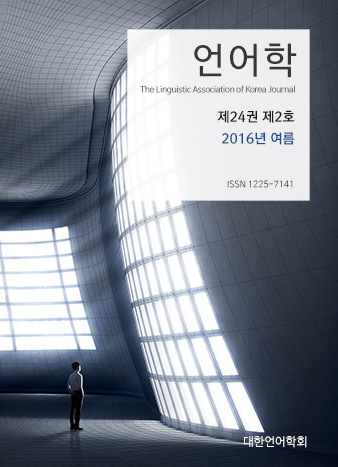대한언어학회 전자저널

-
A Corpus-based Study on the Use of English Present Perfect by Chinese EFL Learners
-
A Study of Curricular Components of English/Korean-Language Textbooks
-
The Effects of Listening Encoding Strategy Use on Korean EFL Learners’ EAP Listening Comprehension
-
A Study on the Correlation between Self-Efficacy Beliefs and Strategies in English Reading
24권 2호 (2016년 6월)
- A Corpus-based Study on the Use of English Present Perfect by Chinese EFL Learners
-
Liu Yi
Pages : 41-55
Abstract
Keywords
# LOCNESS # CLEC # present perfect # English proficiency
References
- Bao, K. & Jin, L. (2010). An Empirical Study on the Influence of Mongolian Tense on the Acquisition of English Present Perfect by Mongolian University Students. Journal of Inner Mongolia Normal University, 23(11), 111-115.
- Cai, J. T. (2010). The Influence of Chinese Aspect Marker le on the Simple Past Marking in English Interlanguage: An Empirical Study of University Students in China. Chinese Journal of Applied Linguistics, 33(2). 35-47.
- Collins, L. (2002). The Roles of L1 Influence and Lexical Aspect in the Acquisition of Temporal Morphology. Language Learning, 52, 43–94.
- Comrie, B. (1976). Aspect. Cambridge: Cambridge University Press.
- Coppieters, R. (1987). Competence Differences between Native and Near-native Speakers. Language, 63, 544-573.
- Duan, M. (2011). A Corpus-based Study of the Misuse of Tenses in the English Composition of Chinese College Students. English Language Teaching, 4(4), 173-180.
- Ellis, R. (1985). Understanding Second Language Acquisition. Oxford: Oxford University Press.
- Flashner, V. (1989). Transfer of Aspect in the English Oral Narratives of Native Russian Speakers. Transfer in Language Production. Norwood: Ablex.
- Granger,S. (1998). The Computer Learner Corpus: A Versatile New Source of Data for SLA Research.Learner English on Computer. London: Addison Wesley Longman. 3-18.
- Gu, K. & Wang, T. S. (2005). Effects of Linguistic Factors on Present Perfect Use. Modern Foreign Languages, 28 (1), 53-60.
- Han, C. X (2006). Error Analysis of Present Perfect in Chinese Students’ English Writings—CLEC Based Approach. Wuhan: Huazhong University of Science and Technology.
- Hantrakuil,C. (1990). English Tense and Aspect Usage in Controlled Written Discourse by Non-native Speakers. Bloomington-Normal: Illinois State University.
- Hinkel, E. (2004). Tense, Aspect and the Passive Voice in L1 and L2 Academic Texts. Language Teaching Research, 8(1), 5-29.
- Hu, J. (2010). A Corpus-based Study on Chinese University Student Acquiring English Present Perfect. Journal of PLA University of Foreign Languages, 6, 55-60.
- Labadi, Y. (1990). A Contrastive Study of Tense and Aspect in English and Japanese: Pedagogical Implications. Austin: University of Texas.
- Leech, G. N. (1971). Meaning and the English Verb. London: Longman.
- Liu, Y. (2009). A Comparative Study of Features on Learning English Present Perfect by Monolinguals and Bilinguals. YanBian: YanBian University.
- McCawley, J. D. (1971). Tense and Time Reference in English. Studies in Linguistic Semantics. New York: Holt, Rinehart & Winston.
- McCoard, R. W. (1978). The English Perfect: Tense-choice and Pragmatic Inferences. Amsterdam: North Holland.
- McEnery, T., Xiao, R., & Tono, Y. (2006). Corpus-based Language Studies: An Advanced Resource Book. London and New York: Routledge Press.
- Montrul, S. (2009). Knowledge of Tense-Aspect and Mood in Spanish Heritage Speakers. International Journal of Bilingualism, 13(2), 239-269.
- Yang, M. (2013). On the Obstacles and Countermeasures in Subjunctive Mood for Chinese EFL Learners. Shanghai: Shanghai International Studies University.